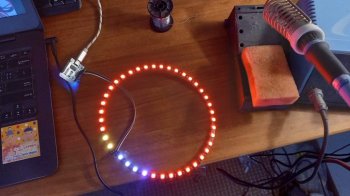PowerLight
| Project PowerLight | |
|---|---|

| |
| Show energy mix of dutch power generation as a pie chart on a LED ring | |
| Status | Completed |
| Contact | bertrik |
| Last Update | 2022-07-28 |
The concept
Draw the current dutch electrical power generation-mix as pie chart on a LED ring light, with colors representing fractions of a specific power generation source.
For example:
- yellow: solar
- blue: wind
- red: fossil
- green: nuclear
- grey: other/waste
Power generation data
Information about energy in Europe is collected at the european organisation https://www.entsoe.eu/ . The section about electrical energy is collected in ENTSO-E. Data is available from this platform at a 15-minute interval.
TenneT is the organisation that supplies ENTSO-E with data from the Netherlands.
Information about ENTSO-E generation domain API: https://transparency.entsoe.eu/content/static_content/Static%20content/web%20api/Guide.html#_generation_domain
Also possibly interesting (requires an API key), but might actually just use the entso-e data: https://static.electricitymap.org/api/docs/index.html#introduction
Power generation categories
The backend uses the following categories
ENTSO-E numbers the production types from B01 to B20 ("PsrType"), how these are filled for the netherlands:
- B01 (biomass): always 0, not useful
- B02: not available
- B03: not available
- B04 (fossil hard coal): useful
- B05 (fossil gas): useful
- B06: not available
- B07: not available
- B08: not available
- B09 (geothermal): not available
- B10 (hydro): not available
- B11 (hydro): always 0
- B12 (hydro): not available
- B13 (marine): not available
- B14 (nuclear): useful
- B15 (other renewable): useful, but what is this?
- B16 (solar): hugely underreported, *not* useful
- B17 (waste): useful
- B18 (wind offshore): useful
- B19 (wind onshore): useful
- B20 (other): ???
The solar power problem
In particular the solar power fraction is incomplete, but also the biomass figures are missing. See:
- https://berthub.eu/articles/posts/dutch-electrical-power-figures-2/ provides a nice overview of the current situation about dutch electrical power generation data
- https://energy-charts.info/charts/energy_pie/chart.htm?l=en&c=NL note how the solar part is tiny, even during the day
There is a model that estimates the solar fraction, also at a regional level, at https://api.netanders.io/, however use of this model requires a paid subscription.
What I'm currently doing for the solar fraction, is to use the ENTSO-E forecast instead of the actual solar numbers reported to them, see yesterday's wind/solar forecast. Perhaps this can also be done for the wind fraction.
Data schedule
Entso-E provides data with a resolution of 15 minutes. It appears to become available about 5m20s after the start of each 15 minute period (:00, :15, :30, :45). At that point, the most recent data is from an interval that ended 30 minutes ago. So, including the 5m20s minute processing delay, the most recent data available is about 35 minutes old.
Hardware
Parts:
- LED ring light https://nl.aliexpress.com/item/1005003798658173.html
- Wemos D1 mini with an ESP8266
Software
The software consists of two parts:
- backend part that collects the power generation data
- light part that visualizes the power generation as fractions on a LED ring
Backend
Source code: https://github.com/bertrik/energymix-server
Runs as a REST-like resource at http://stofradar.nl:9001/energy/latest (1-minute rate limit)
The backend uses the following categories:
- solar = B16 (from the forecast document)
- wind = B18 + B19
- fossil = B04 + B05
- nuclear = B14
- waste = B17
- other = B15 + B20
Returns a JSON-structure like:
{
"time": 1657057500,
"total": 9122,
"mix": [
{ "id": "solar", "power": 0, "color": "#FFFF00"},
{ "id": "wind", "power": 4, "color": "#0000FF"},
{ "id": "fossil", "power": 86, "color": "#FF0000"},
{ "id": "nuclear", "power": 5, "color": "#FF00FF"},
{ "id": "other", "power": 4, "color": "#444444"},
{ "id": "waste", "power": 1, "color": "#444444"}
]
}
- time is a unix time stamp in seconds, representing the end of the 15-minute period that the power figures refer to
- total is the total current electrical power (megawatt), suitable for display (on a numeric display inside the ring for example)
- energymix is an array of power sources, each with:
- a short unique id
- most recent known power (megawatt)
- hex color, for display on the led ring
Light
Source code: https://github.com/bertrik/PowerLight
The Arduino sketch polls the REST API using HTTP every minute.
WiFi is managed by WifiManager. LEDs are controlled using FastLED. JSON content is parsed using ArduinoJSON.